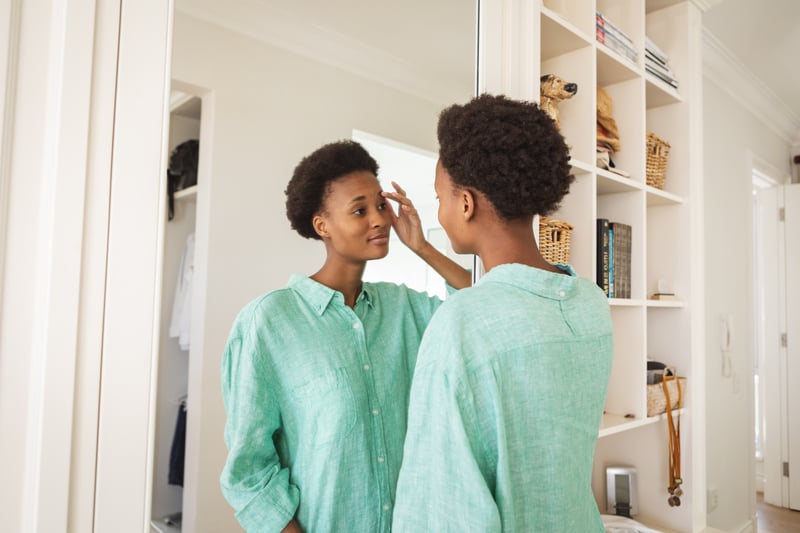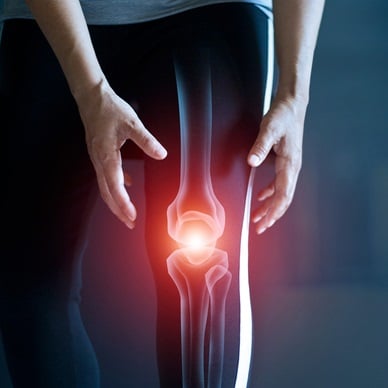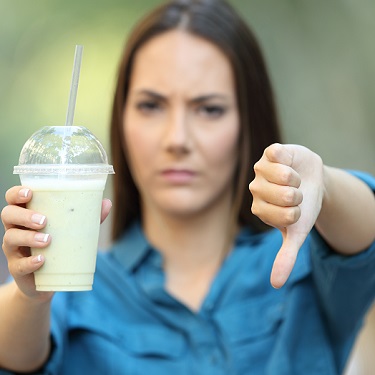How to Get Rid of Bags Under Eyes Naturally (8 Tips)

Finding yourself with puffy under-eye bags, whether temporary (i.e., after a rough night) or chronically (they never seem to go away), is pretty much inevitable for all of us at some point. Indeed, it’s a super common issue, especially as we get older. Who wouldn’t want to get rid of bags under eyes?!
Yet under-eye bags can be caused by different issues, and thus, what we do to combat them may differ. For example, under-eye bags may result from temporary swelling due to water retention after consuming a lot of salt, due to seasonal allergies, or from lack of sleep. They may also be part of the natural aging process due to “herniated fat pads.” This term sounds scary, but it just means that the tissue under the eyes has repositioned. This is because, over time, the fat naturally found under the eye can push on the muscle and structure that holds it in place, pushing the lower lid out. It’s a natural result of getting older, genetics, and gravity as the ligaments, tendons, and skin under the eyes relax and fall, bulge, or pooch.
Under-eye bags shouldn’t be confused with dark circles, though they do sometimes occur together. Dark circles can result from changes in the skin pigment or texture. For example, as the skin thins, the blood vessels beneath the surface can become more pronounced, making it look darker.
Both issues can make eyes look tired or older, especially when combined. Dark circles can even look more pronounced by fat pad herniation as it shadows the under-eye, making it look darker and puffier.
All of this is to say that if you suffer from under-eye bags or dark circles, you’re not alone. Not by a long shot. And figuring out what is causing the excess baggage can help you find the right way to get rid of under-eye bags.
8 Common Causes of Under-Eye Bags
1. Dehydration and Water Retention
Too much salt, typically from eating lots of processed foods, can cause the body to retain water and lead to puffiness, including under the eyes. Interestingly, it’s also why your eyes get puffy after crying. The saltiness of tears draws water into the tissues under the eyes, which causes them to swell.
Solution to get rid of bags under eyes: Ease off of processed foods and watch your sodium intake. In addition, ensure you’re consuming enough potassium to help counterbalance the excess sodium and prevent fluid buildup and the swelling that can cause. Foods rich in potassium include avocados, bananas, beans, lentils, potatoes, dark leafy greens, nuts, and more.
Of course, you’ll want to also drink plenty of water. So, keep a water bottle close by to sip on throughout the day. Recommendations are 9 to 13 cups of fluids per day, depending on your size. Water is the most convenient, calorie- and (typically) cost-free way to hydrate. But you can also enjoy sparkling waters, flavored waters, fruit-infused water, or herbal teas (hot or chilled) for greater variety.
In addition, alcohol consumption can also lead to dehydration, and dehydration can lead to under-eye bags and dark shadows under the eyes. In short, cutting back on boozy drinks may help reduce under-eye bags.
2. Seasonal Allergies
The congestion and inflammation caused by pollen as the seasons change can make under-eye bags that much worse. As eyes get red and watery, the tender tissue around the eyes can become inflamed and swollen, so you not only don’t feel great but have a hard time looking your best.
Solution to get rid of bags under eyes: There’s no perfect solution to allergy season—other than perhaps moving away from spring flowers and budding trees. It may, however, help to stay indoors, especially on days when the weather is dry and windy. If possible, save outdoor activities for times when it’s rained recently, which can help tamp down the pollen levels. You may also want to shower and remove any pollen from your clothing after spending time outdoors.
If you know that pollen counts are in the forecast, after discussing with your doctor, it can help to take allergy medications (such as Benadryl, Zyrtec, or Claritin) before symptoms arise. These types of over-the-counter antihistamines or decongestants may help fight the watery eyes, sniffly nose, and puffiness around the eyes.
You may also notice that swelling goes down throughout the day as gravity naturally helps reduce pressure and congestion.
Seasonal allergies aren’t the only allergies, obviously. If you experience allergic reactions at other times or haven’t had seasonal allergies in the past, the culprit may be a new soap, perfume, makeup, or dye. Look around your environment to see if you’re reacting to something around you.
3. Sleep Habits
Not getting enough sleep and how you sleep can both impact how well-rested you look when you wake up. For example, if you don’t get enough sleep, your complexion can look pale, making dark, puffy eyes more obvious. And if you sleep on your side or flat on your back, fluid can pool around the lower eyelids, leading to increased puffiness.
Solution to get rid of bags under eyes: Get seven to nine hours of sleep every night, and preferably shoot for more than eight if you have dark under-eye circles. To make sure you’re enjoying quality sleep, practice healthy sleep hygiene.
Next, give elevating your head as you sleep a try. Simply stack up a couple (or more) pillows to lean back against, or consider getting a wedge pillow to lift your head as you sleep to help prevent the fluid from pooling. Can’t sleep in this position? Consider just elevating the top of the entire bed by propping a couple of blocks, bricks, or bed risers, which will lift the bed just a couple of inches.
It’s also important to remove any makeup before you head off to bed, as falling asleep with makeup on, especially with mascara and eyeshadow, can irritate the eyes or lead to an infection that can increase puffiness, redness, or dark shadows.
4. Genetics and Getting Older
If your family members have under-eye bags, especially if they become more pronounced as they get older, you will likely have them as well. That’s because they’re a physical characteristic that can pass from one generation to the next (thanks, mom and dad!). In fact, because the skin under the eyes is notoriously thin and fragile, under-eye bags are a common result of aging as both the skin and muscles around the eyes relax and fall.
Solution to get rid of bags under eyes: While you may never get rid of your natural under-eye bags, you may be able to delay them or reduce their appearance. For example, you may be able to reduce swelling by:
• Applying a cold compress, which helps reduce inflammation and swelling. Anything chilled can work, such as refrigerated spoons, chilled cucumber slices, ice packs, a chilled wet washcloth, or a bag of frozen vegetables. (There’s no need to purchase a special compress.) After your compress has been chilled, while sitting upright, place it on the eyes, keeping them closed, and relax for a few minutes as your blood vessels constrict to help temporarily reduce swelling.
• Chilled jade rollers or rollerball applicator tips may also work wonders. Start from the inside corner of the eye and very gently roll outward, which may help flush out fluid.
• Applying caffeine under the eyes, as caffeine is known to increase blood flow to the skin. You can try placing damp tea bags (preferably caffeinated green tea). Tea also provides antioxidants which may be beneficial to the skin. Start by steeping two tea bags. While you’re enjoying your cup of tea, place the tea bags in the fridge to chill for about 20 minutes. Remove the excess liquid from the bags and place a tea bag on each eye. Keep your eyes closed and rest and relax (while sitting upright) for the next 15 to 30 minutes, as the tea bags help reduce swelling around the eyes.
There are some cosmetic creams available that contain caffeine for this reason. Again, the impact may be transient, but these types of products have been shown to help relieve puffiness. And because they contain antioxidants, they may help protect against free radicals for longer-term benefits.
Some people have suggested using over-the-counter hemorrhoid creams as one of the main ingredients (phenylephrine) can also narrow blood vessels and thus help reduce swelling. However, these products should only be used with caution as they can be harsh and irritating to the delicate skin under the eyes. They can also be harmful if they get into the eyes.
5. Collagen Deficiency
As we age, the amount of collagen in our bodies naturally decreases. Yet collagen makes up 30% of the protein in the body and up to 70% of the protein in the skin. As the primary structural protein in the body, it’s vital to the health of the joints, bones, cartilage, ligaments, hair, fingernails, and skin. And as we age and collagen levels decline, it can lead to the skin sagging. That, of course, includes the area around the eyes.
Solution to get rid of bags under eyes: Consuming collagen and proteins through the diet can help provide the building blocks the body needs to increase collage levels in the body. Quality collagen supplements are perhaps the most convenient way to provide collagen.
In addition to consuming collagen, it may help support the body’s ability to produce collagen. Foods rich in vitamin C can help the body better absorb hyaluronic acid, which is also important for collagen production. Including vitamin C-rich foods like red peppers, chili peppers, kale, oranges, Brussels sprouts, broccoli, strawberries, kiwi, etc., can help support healthy, younger-looking skin.
6. Neglecting Skincare
What you eat can dramatically impact the skin, but how you care for your skin can also affect its health, strength, healing, and beauty.
For example, some common ingredients are found in some quality skin-care products that may improve collagen levels in the skin more directly. Retinol, a form of vitamin A, for example, found in various creams, gels, and liquids, is often marketed to help reduce the signs of aging. The small molecules may get deep into the outer layer of the skin to help neutralize free radicals, boost elastin and collagen production, and help “plump the skin” and reduce fine lines.
Typical recommendations are to apply retinol products to a clean face once per day. However, it takes several weeks for results to become apparent, and for some people, it can make skin feel dry, irritated, itchy, or red. If you are starting with a new skin product, begin slowly, applying only every other night or every third night. Retinol may also increase photosensitivity to sunlight, so make sure you use sunscreen.
Of course, no matter what products you’re using, it’s important to prevent UV damage to begin with. In addition to using sunscreen regularly, provide extra protection for the delicate skin around the eyes by wearing sunglasses and perhaps adding in a fashionable sunhat to better shade the eye area.
Other skin-care ingredients that may help support collagen in the skin include hyaluronic acid, peptides, and vitamin C. Potential benefits include stronger, thicker skin, which may help (over the long term) the herniated fat pad become less obvious and reduce dark circles.
Finally, don’t be afraid to experiment with concealer under the eyes. Using a peach color may help reduce the appearance of dark circles and puffiness. And a greener shade may help better conceal redness. Apply in the shape of an upside-down triangle with dots (less is typically better when it comes to concealers) and then gently pat in lightly with a makeup blender. According to makeup artists, it generally is better to choose a color that’s one shade lighter than your skin tone or foundation for a more neutral appearance.
7. Smoking
Most of us are well aware of the pitfalls of smoking, and skin damage is one more reason to find ways to quit. Tobacco smoke depletes vitamin C, and vitamin C is vital for producing healthy collagen.
Smoking can lead to wrinkles, discoloration, dark circles, and under-eye bags, especially as you age, causing people to look older than their age.
Solution to get rid of bags under eyes: Quitting isn’t easy, but it’s always worth it. It can add years to your life, improve the look of your skin and teeth, and reduce the risk of a wide variety of diseases, including diabetes, cardiovascular disease, and many cancers.
There are many different ways to approach quitting. Some people do so cold turkey, others get help from doctors or support groups, many have to try several different methods to find the one that works best for them. There’s no right or wrong way to quit.
8. Medical conditions
Most causes of under-eye bags aren’t serious and can be addressed at home. They’re typically a cosmetic concern rather than a medical one. But if you notice the steps you are taking aren’t helping, or they’re getting worse, you may want to visit a healthcare professional. This is especially true if the swelling or discoloration is long-lasting, severe, accompanied by other symptoms, or affects other systems in the body.
Solution to get rid of bags under eyes: Physicians can help you address issues that may be leading to the under-eye bags, such as thyroid issues, iron deficiency (anemia), or insomnia.
If there aren’t any underlying causes, a dermatologist may be able to offer other options such as prescription creams, laser therapy, chemical pills, injectable fillers, or others if natural solutions aren’t able to give you the results you’re looking for.
How to Get Rid of Under-Eye Bags: A Recap
Especially as we get older, it may never be possible to completely or permanently remove under-eye bags. By knowing the cause, and addressing the underlying issue, this can help reduce puffiness, increase the strength and thickness of the skin around the eyes, and help reduce the appearance of under-eye bags.
Remember, though, that aging is normal, natural, and a fact of life for all of us. While we can take steps to improve our health and appearance, aging is something to embrace rather than resist (after all, not everyone has this privilege).







 US Doctor: "Eating This Every Day Can Snap You Into Ketosis"
US Doctor: "Eating This Every Day Can Snap You Into Ketosis" 3 Key Nutrients to Help Lubricate Your "Tin Man" Joints
3 Key Nutrients to Help Lubricate Your "Tin Man" Joints AVOID Plant-Based Protein Powders (unless...)
AVOID Plant-Based Protein Powders (unless...)

